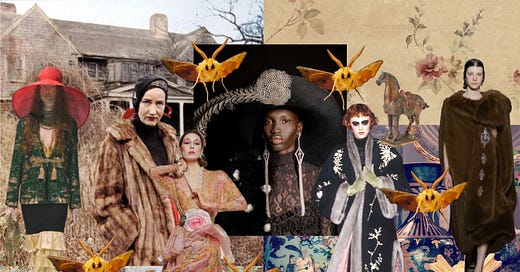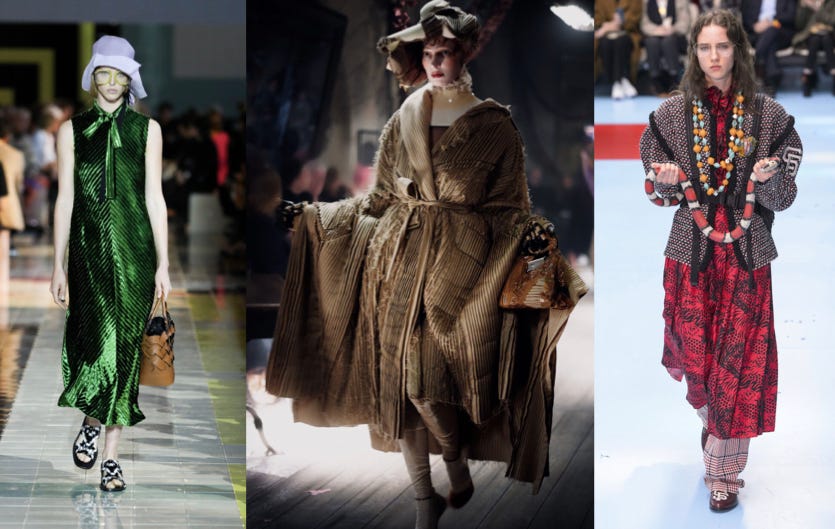Towards the back half of 2019, I was bouncing around fashion predictions for the next year with the other girls on my team. I was still living in London at the time and going to an office in Farringdon every day. Upon entering a new decade, we were optimistically envisioning a potential return to the roaring twenties.
We’d seen similar trains of thought across fashion media publications and references to the era had cropped up in ready-to-wear collections. 1920s-inspired cocoon coats at Dries Van Noten. Drop-waist dresses, cloche hats and feathers at Prada. Ralph Lauren transformed into a jazz club, with Janelle Monáe performing and the runway brimming with jewel tones, beads, satin, velvet and lamé. As we know, this aesthetic never materialized and we spent 2020 rotting indoors in loungewear.
Five years on, I’m betting that this level of opulence will return in 2025, but with a twist. It’ll be mustier, more whimsical, and 70s-leaning. I’m calling it Moth-Eaten Maximimalism, an eccentric, decaying glamor that’s associated with caricatures of affluent but eclectic relatives. Think Grey Gardens meets Alessandro Michele’s Valentino with a dash of flea market charm. Not exactly my style, but here’s why it’ll be big in 2025.

Firstly, the personal style crisis. I’ve previously written at length about micro trends impacting taste and style. The fatigue for every aesthetic suffixed with “core” or “girl” that bled from TikTok to IRL has ushered in an appreciation for all things weird and wacky. We saw this at the start of 2024; the Eclectic Grandma/Grandpa hit the headlines as an effort to escape the uniformity of social media aesthetics, but it was paradoxical - a micro trend cosplaying as personal style.
TikTok is now used like Google and there are over 70 million videos with #personalstyle attached as we try and decipher our own tastes. In this mission, offline recognizance is required alongside experimentation with the weird.
And the weird is emerging from the woodwork. The Five-Finger shoe. Beaded mesh slippers have been deemed cool again. Prada’s everything, everywhere, all at once, break-the-algorithm collection. Then Michele’s divisive Valentino, which fashion critic Cathy Horyn described as stuffy and costume-y (personal hard agree). This is the essence of Moth-Eaten Maximalism. It’s grand, its a bit old-fashioned, it’s not for everybody. Our yearning for weirdness and obsession with nostalgia will culminate into this kind of antique opulence spotlighting:
Aged fur coats and fur trim robes, long dresses, pussybow blouses, crushed velvet.
Clashing baroque, polka dots, vintage wallpaper florals, animal prints.
Extravagant heirloom jewlrey - brooches, pearls, diamonds.
Intricate embroidery, sequins, feathers, embellishments, tassels, beading, ruffles.
Silk turbans, OTT hats, long tasseled scarves, lace gloves, statement glasses.
Maximalism is becoming more appealing to younger generations. There has been a significant spike in US Pinterest searches for the term in fashion since August, with Gen Z leaning more toward this aesthetic. They account for 55% of searches for this term vs. 26% for minimalism, which is more readily searched for by 25-44 year-olds.
Another reason I think we will start to see more of this look is we can’t escape the rule of the rich and aspirations for wealth. The Moth-Eaten Maxamilist exudes old money, though she isn’t taking cues from a polished heiress or Sofia Richie Grainge type. She’s more inspired by an eclectic child-free aunt or kooky grandmother. In a sense, seeing this look emerge in the 2020s mirrors today’s social standing outside the 1% - a convergence of dreaming of wealth while living in decay.
According to The Washington Post, homeschooling has become the fastest-growing form of education in the US, offering more time with family and opportunities to cross paths with eccentric relatives, raid their wardrobes, and admire their antiquities (though perhaps a naive thought given our tech-obsessed culture). Plus, the cost of having and raising children in this economy makes it more appealing to be a wealthy childless cat lady (at least for me anyway), with several of the aforementioned elements crossing over with the wardrobe of this stereotype that has transcended from an insult to an aspirational lifestyle.
Moth-Eaten Maximalism won’t be limited to the rich. Furthering its case is the booming second-hand market and our constant romanticization of the archives. Out of necessity or in our search for the unique, we’re trawling charity shops and flea markets. Anything kitsch is seen as trendy as tastemakers weigh down handbags with trinkets and emblazon outfits with brooches.
Additionally, while ageism remains perverse in fashion, older generations have cemented themselves as industry icons. This, of course, is more prevalent in men - in the upcoming weeks, I am planning to write something along the lines of “Are Old Blokes Fashion’s New It Girls?” following Willem Dafoe being the model of the moment for Zalando and Miu Miu, Daniel Craig for Loewe and the Oasis reunion. As we hit peak youth obsession and influencer fatigue, I’m hoping to see more campaigns along the lines of Joan Didion for Céline and Dame Maggie Smith for Loewe, may they both rest in peace.
Could this era of Moth-Eaten Maxamilism also become a conduit for greater age diversity in fashion and challenge the definition of luxury and beauty? In a world obsessed with perfection, decay is inevitable - a universal truth that is deeply emotional and profoundly human.









I am that eccentric childfree cat-loving aunt! And my husband and I have been impatiently waiting for maximalism to swing back into style, hooray! 💕Love it!
love this!